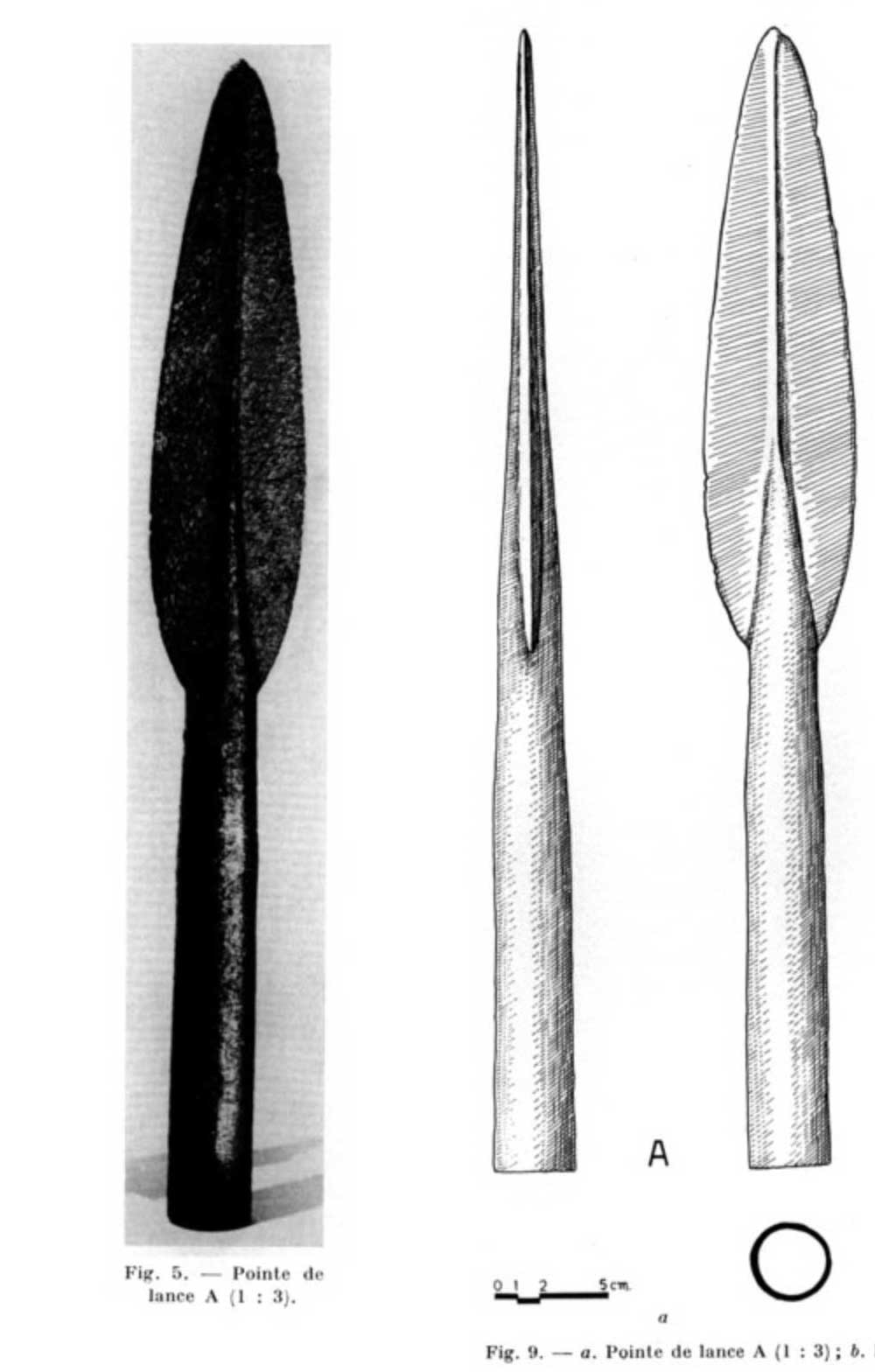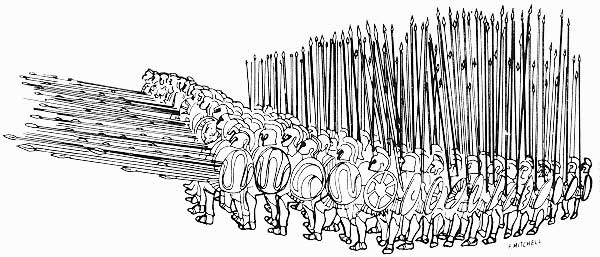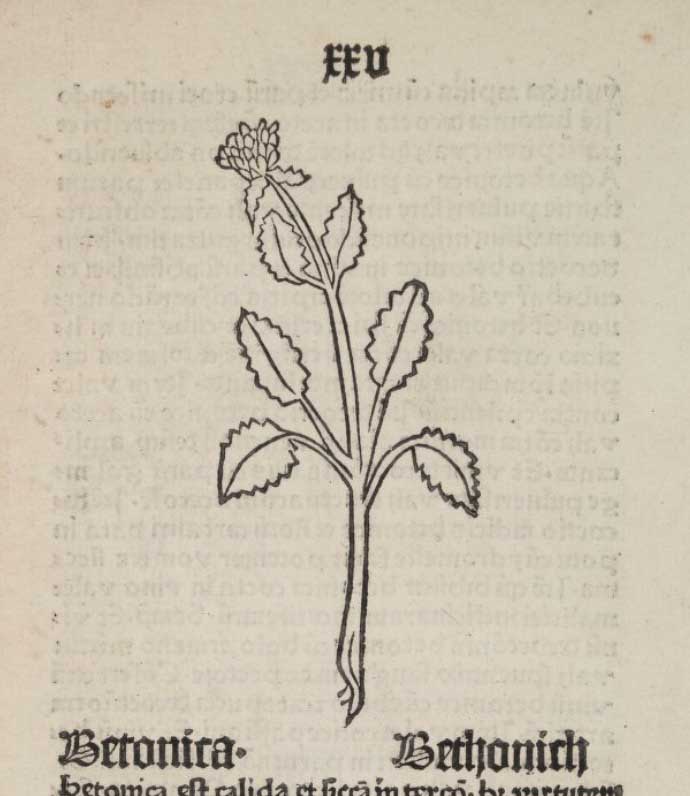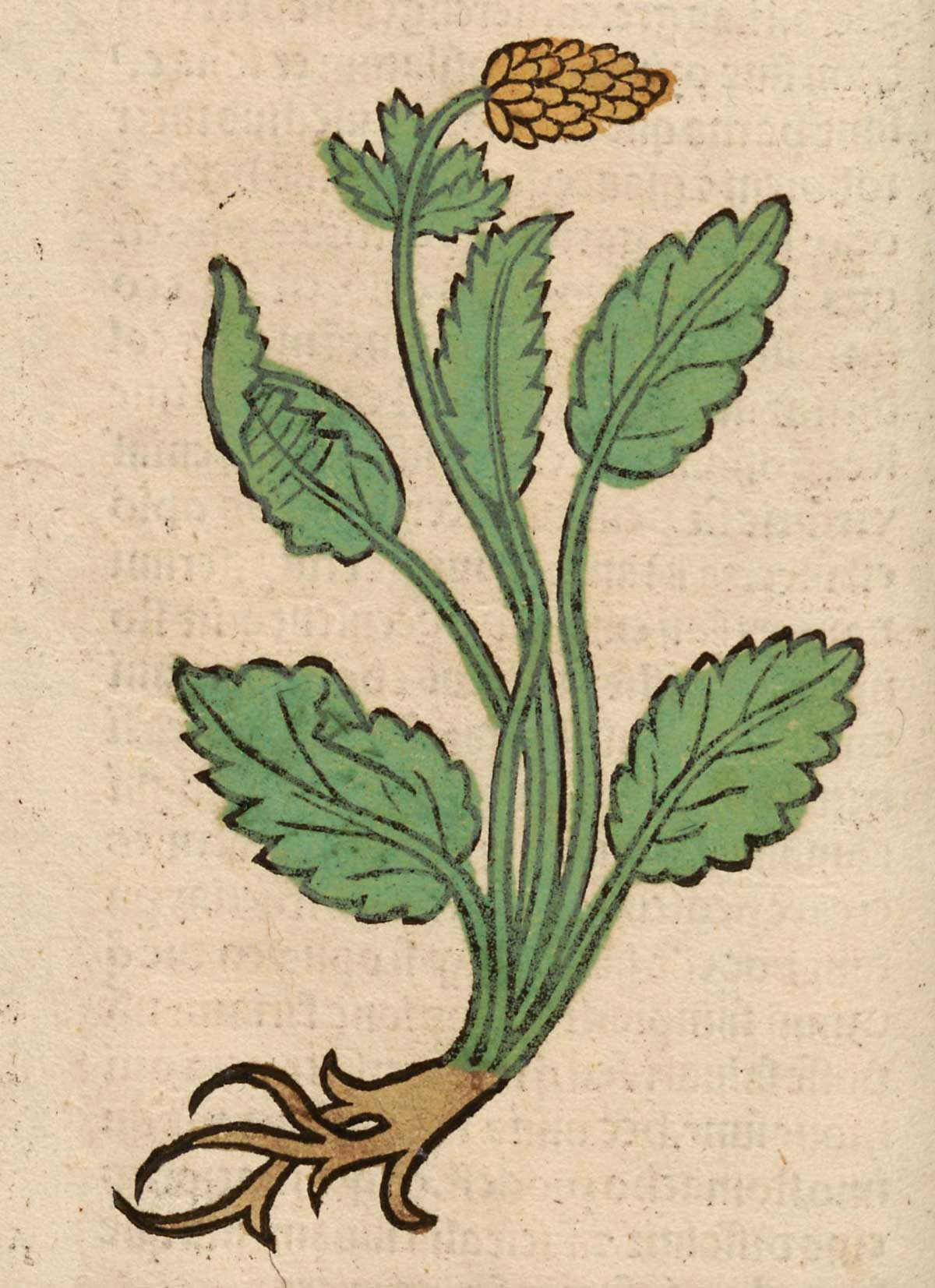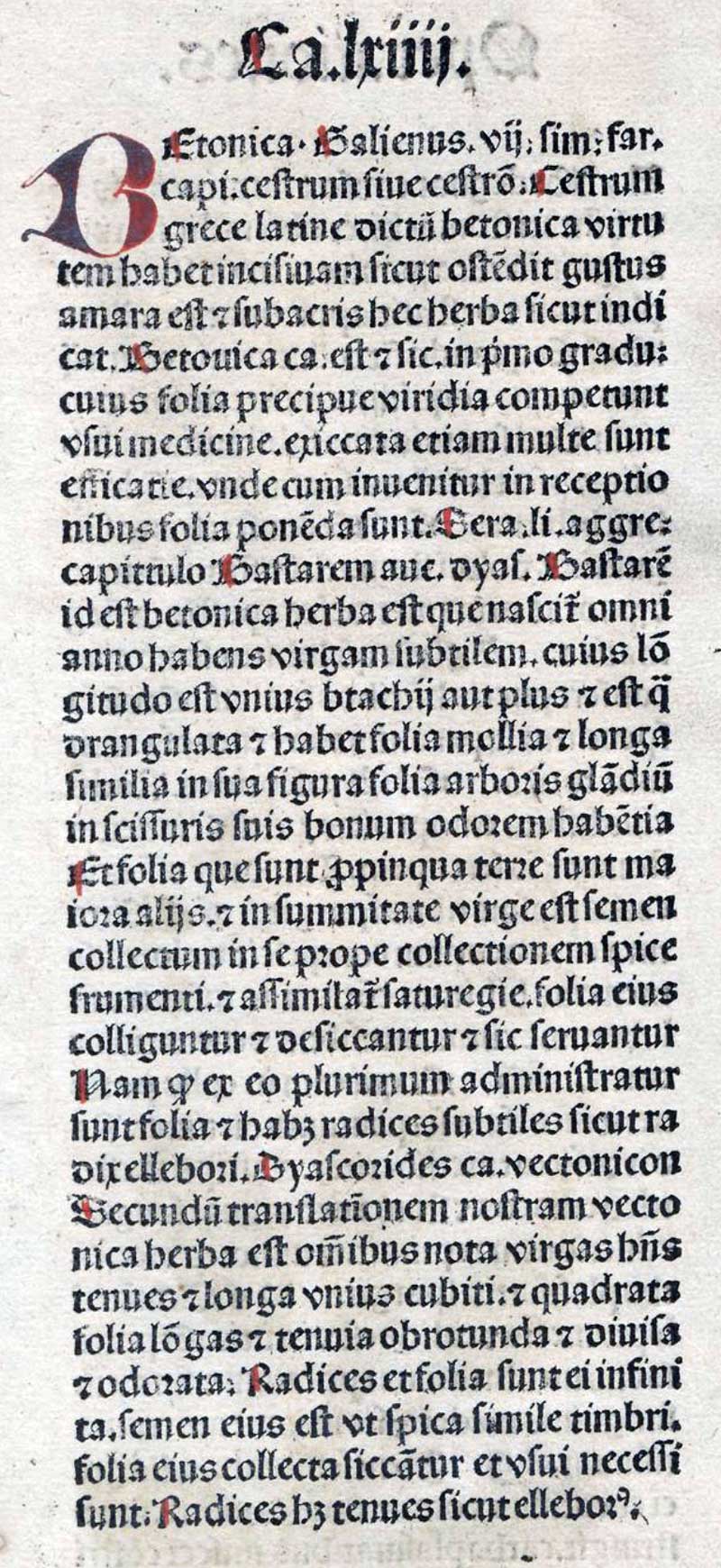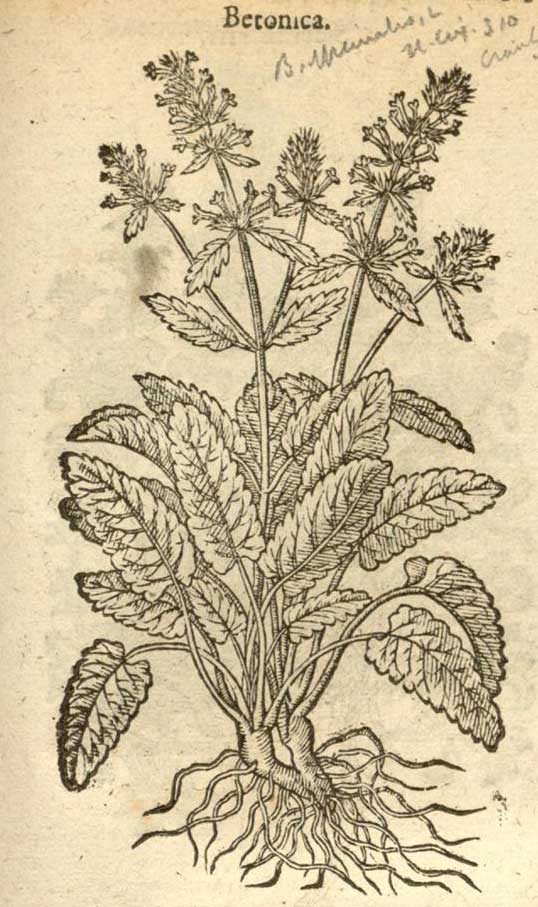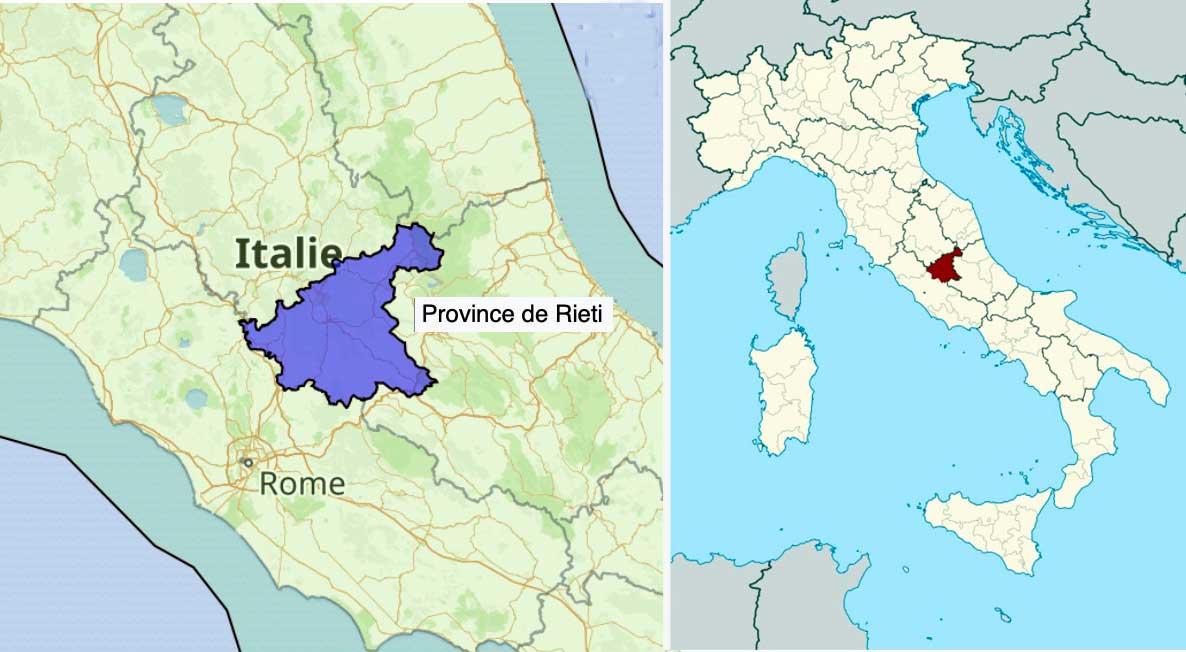Notes
Palestrina
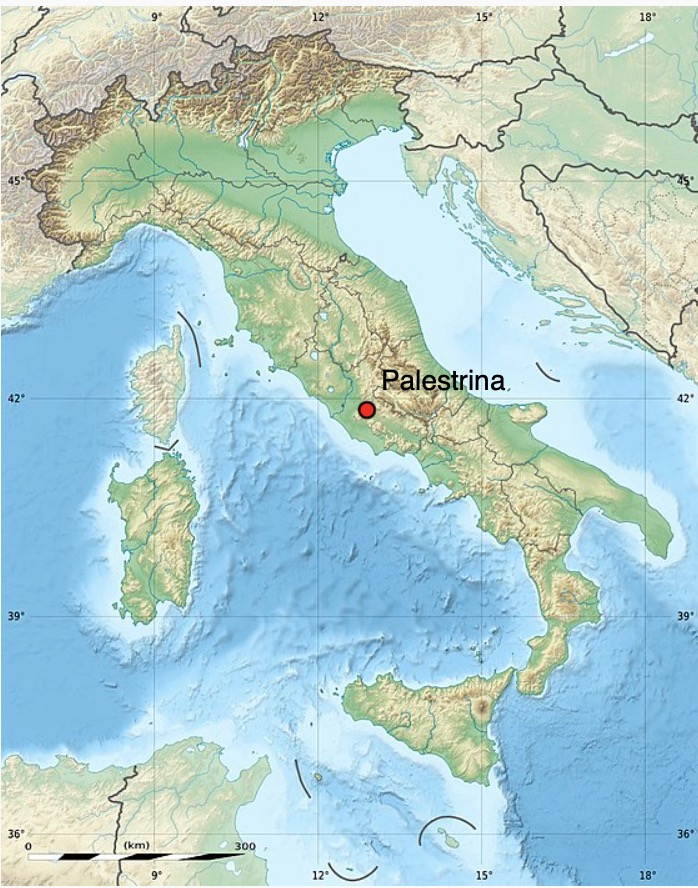
Préneste (ou Præneste) est une ancienne ville du Latium à 37 km à l’est de Rome. Actuellement nommée Palestrina, la ville était située sur une hauteur stratégique des Apennins.
Praeneste
Lots and the Chaldean astrologers remain to be discussed before we come to prophets and to dreams. And pray what is the need, do you think, to talk about the casting of lots? It is much like playing at morra, dice, or knuckle-bones, in which recklessness and luck prevail rather than reflection and judgement. The whole scheme of divination by lots was fraudulently contrived from mercenary motives, or as a means of encouraging superstition and error. But let us follow the method used in the discussion of soothsaying and consider the traditional origin of the most famous lots. According to the annals of Praeneste Numerius Suffustius, who was a distinguished man of noble birth, was admonished by dreams, often repeated, and finally even by threats, to split open a flint rock which was lying in a designated place. Frightened by the visions and disregarding the jeers of his fellow-townsmen he set about doing as he had been directed. And so when he had broken open the stone, the lots sprang forth carved on oak, in ancient characters. The site where the stone was found is religiously guarded to this day. It is hard by the statue of the infant Jupiter, who is represented as sitting with Juno in the lap of Fortune and reaching for her breast, and it is held in the highest reverence by mothers.
There is a tradition that, concurrently with the finding of the lots and in the spot where the temple of Fortune now stands, honey flowed from an olivetree. Now the soothsayers, who had declared that those lots would enjoy an unrivalled reputation, gave orders that a chest should be made from the tree and the lots placed in the chest. At the present time the lots are taken from their receptacle if Fortune directs [If the statue of the goddess gives a sign by a nod or otherwise]. What reliance, pray, can you put in these lots, which at Fortune’s nod are shuffled and drawn by the hand of a child? And how did they ever get in that rock? Who cut down the oaktree? and who fashioned and carved the lots? Oh! but somebody says, ‘God can bring anything to pass.’ If so, then I wish he had made the Stoics wise, so that they would not be so pitiably and distressingly superstitious and so prone to believe everything they hear! This sort of divining, however, has now been discarded by general usage. The beauty and age of the temple still preserve the name of the lots of Praeneste—that is, among the common people, for no magistrate and no man of any reputation ever consults them; but in all other places lots have gone entirely out of use. And this explains the remark which, according to Clitomachus, Carneades used to make that he had at no other place seen Fortune more fortunate than at Praeneste [i.e. the reputation of the lots at Praeneste lasted longer than elsewhere]. Then let us dismiss this branch of divination.
Cicero, Marcus Tullius (106 BC-43 BC),
De Divinatione. W. A Falconer, translator. Cambridge, Massachusetts: Harvard University Press, 1923. 2.41 §§ 86, 87, p. 467.
Loeb Classical Library
Comment Panurge prend conseil de Epistemon. Chapter 24
Laissans la Villaumère, & retournans vers Pantagruel, par le chemin Panurge s’adressa à Epistemon, & luy dist.
Compère mon antique amy, vous voyez la perplexité de mon esprit. Vous sçavez tant de bons remèdes. Me sçauriez vous secourir?
Epistemon print le propous, & remonstroit Panurge comment la voix publicque estoit toute consommée en mocqueries de son desguisement: & luy conseilloit prendre quelque peu de Ellebore, affin de purger cestuy humeur en luy peccant, & reprendre ses accoustremens ordinaires.
Ie suys (dist Panurge) Epistemon mon compère, en phantasie de me marier. Mais ie crains estre coqu & infortuné en mon mariage. Pourtant ay ie faict veu à sainct François la ieune, lequel est au Plessis lez Tours reclamé de toutes femmes en grande devotion (car il est premier fondateur des bons hommes, lesquelz elles appetent naturellement) porter lunettes au bonnet, ne porter braguette en chausses, que sus ceste mienne perplexité d’esprit ie n’aye eu resolution aperte.
C’est (dist Epistemon) vrayment un beau & ioyeulx veu. Ie me esbahys de vous, que ne retournez à vous mesmes, & que ne revocquez vos sens de ce farouche esguarement en leur tranquillité naturelle. Vous entendent parler, me faictez souvenir du veu des Argives à la large perrucque, les quelz ayant perdu la bataille contre les Lacedaemoniens en la controverse de Tyrée, feirent veu: cheveux en teste ne porter, iusques à ce qu’ils eussent recouvert leur honneur & leur terre: du veu aussi du plaisant Hespaignol Michel Doris, qui porta le trançon de grève en sa iambe. Et ne sçay lequel des deux seroit plus digne & meritant porter chapperon verd & iausne à aureilles de lièvre, ou icelluy glorieux champion, ou Enguerrant qui en faict le tant long, curieux, & fascheux compte, oubliant l’art & manière d’escrire histoires, baillée par le philosophe Samosatoys. Car lisant icelluy long narré, l’on pesne que doibve estre commencement, & occasion de quelque forte guerre, ou insigne mutation des Royaulmes: mais en fin de compte on se mocque & du benoist champion, & de l’Angloys qui le deffia, & de Enguerrant leur tabellion: plus baveux qu’un pot à moustarde. La mocquerie est telle que de la montaigne d’Hiorace, laquelle crioyt & lamentoyt enormement, comme femme en travail d’enfant. A son cris & lamentation accourut tout le voisinaige en expectation de veoir quelque admirable & monstrueux enfantement, mais en fin ne nasquit d’elle qu’une petite souriz.
Non pourtant (dist Panurge) ie m’en soubrys. Se mocque qui clocque. Ainsi seray comme porte mon veu. Or long temps a que avons ensemble vous & moy, foy & amitié iurée, par Iuppiter Philios, dictez m’en vostre advis. Me doibz ie marier, ou non?
Certes (respondit Epistemon) le cas est hazardeux, ie me sens par trop insuffisant à la resolution. Et si iamais feut vray en l’art de medicine le dict du vieil Hippocrates de Lango, IUGEMENT DIFFICILE, il est cestuy endroict verissime. I’ay bien en imagination quelques discours moienans les quelz nous aurions determination sus vostre perplexité. Mais ilz ne me satisfont poinct apertement. Aulcuns Platonicques disent que qui peut veoir son Genius, peut entendre ses destinées. Ie ne comprens pas bien leur discipline, & ne suys d’advis que y adhaerez. Il y a de l’abus beaucoup. I’en ay veu l’expereince en un gentil home studieux & curieux on pays d’Estangourre. C’est le poinct premier. Un aultre y a. Si encores regnoient les oracles de Iuppiter en Mon: de Apollo en Lebadie, Delphes, Delos, Cyrrhe, Patare, Tegyres, Preneste, Lycie, Colophon: en la fontaine Castallie près Antioche en Syrie: entre les Branchides: de Bacchus, en Dodone: de Mercure, en Phares près Tatras: de Apis, en Aegypte: de Serapis, en Canobe: de Faunus, en Maenalie & en Albunée près Tivoli: de Tyresias, en Orchomène: de Mopsus, en Cilicie: de Orpheus, en Lesbos: de Trophonius, en Leucadie. Ie seroys d’advis (paradventure non seroys) y aller & entendre quel seroit leur iugement sus vostre entreprinse. Mais vous sçavez que tous sont devenuz plus mutz que poissons, depuys la venue de celluy Roy servateur, on quel ont prins fin tous oracles & toutes propheties: comme advenente la lumière du clair Soleil disparent tous Lutins, Lamies, Lemures, Guaroux, Farfadetz, & Tenebrions. Ores toutesfoys qu’encores feussent en règne, ne conseilleroys ie facillement adiouster foy à leurs responses. Trop de gens y ont esté trompez. D’adventaige mist sus à Lollie la belle, avoir interrogué l’oracle de Apollo Clarius pour entendre si mariée elle seroit avecques Claudius l’empereur. Pour ceste cause feut premierement banie, & depuys à mort ignominieusement mise.
Mais (dist Panurge) faisons mieulx. Les isles Ogygies ne sont loing du port Sammalo, faisons y un voyage après qu’aurons parlé à nostre Roy. En l’une des quatre, laquelle plus à son aspect vers Soleil couchant, on dict, ie l’ay leu en bons & antiques autheurs, habiter plusieurs divinateurs, vaticinateurs, & prophètes: y estre Saturne lié de belles chaines d’or, dedans une roche d’or, alimenté de Ambrosie & Nectar divin, les quelz iournellement luy sont des cieulx transmis en abondance par ne sçay quelle espèce d’oizeaulx (peut estre que sont les mesmes Corbeaulx, qui alimentoient es desers sainct Paul premier hermite) & apertement predire à un chascun qui veult entendre son sort, sa destinées, & ce que luy doibt advenir. Car les Parces rien ne sillent, Iuppiter rien ne propense & rien ne delibère, que le bon père en dormant ne congnoisse. Ce nous seroit grande abbreviation de labeur, si nous le oyons un peu sus ceste mienne perplexité.
C’est (respondit Epistemon) abus trop evident, & fable trop fabuleuse. Ie ne iray pas.
Rabelais, François (1494?–1553),
Le Tiers Livre des Faicts et Dicts Heroïques du bon Pantagruel: Composé par M. Fran. Rabelais docteur en Medicine. Reueu, & corrigé par l’Autheur, ſus la cenſure antique. L’Avthevr svsdict ſupplie les Lecteurs beneuoles, ſoy reſeruer a rire au ſoixante & dixhuytieſme Liure. Paris: Michel Fezandat, 1552. Chapter 24, p. 79.
Les Bibliotèques Virtuelles Humanistes
Chapter 24. How Panurge taketh Counsel of Epistemon
As they were leaving Villaumere and returning towards Pantagruel, on the way Panurge addressed himself to Epistemon, and said to him: “Gossip, my ancient Friend, you see the Perplexity of my Mind. And you know such a Number of good Remedies. Could you not succour me?”
Epistemon took up the Subject, and represented to Panurge how the common Talk was entirely taken up with Scoffings at his Disguise; wherefore he advised him to take a little Hellebore, in order to purge him of this peccant Humour, and to resume his ordinary Apparel.
“My dear Gossip Epistemon,” quoth Panurge, “I am in a Fancy to marry me, but I am afraid of being a Cuckold and unfortunate in my Marriage.
“Wherefore I have made a Vow to Saint Francis the Younger [1], who at Plessis-lez-Tours is in much Request and Devotion of all Women (for he is the first Founder of the Fraternity of Good Men, whom they naturally long for), to wear Spectacles in my Cap and to wear no Cod-piece on my Breeches, till I have a clear Settlement in the Matter of this my Perplexity of Mind.”
“’Tis indeed,” said Epistemon, “a rare merry Vow. I am astonished that you do not return to yourself and recall your Senses from this wild Straying abroad to their natural Tranquillity. “When I hear you talk thus, you remind me of the Vow of the Argives of the long Wig [2], who having lost the Battle against the Lacedaemonians in the Quarrel about Thyrea, made a Vow not to wear Hair on their Head till they had recovered their Honour and their Land; also of the Vow of the pleasant Spaniard Michael Doris, who ever carried the Fragment of Thigh-armour on his Leg.
” And I do not know whether of the two would be more worthy, and deserving to wear a green and yellow [3] Cap and Bells with Hare’s Ears, the aforesaid vainglorious Champion, or Enguerrant [4], who makes concerning it so long, painful and tiresome an Account, quite forgetting the proper Art and Manner of writing History, which is delivered by the Philosopher of Samosata [5] ; for in reading this long Narrative, one thinks it ought to be the Beginning and Occasion of some formidable War, or notable Change in Kingdoms. But at the End of the Story one only scoffs at the silly Champion, and the Englishman who defied him, as also at the Scribbler Enguerrant, who is a greater Driveller than a Mustard-pot.
“The Jest and Scorn thereof is like that of the Mountain in Horace [6], which cried out and lamented enormously, as a Woman in Travail of Child-birth. At its Cries and Lamentation the whole Neighbourhood ran together, in expectation to see some marvellous and monstrous Birth, but at last there was born of it nought but a little Mouse.”
“For all your mousing,” said Panurge, “I do not smile[7] at it ‘Tis the Lame makes game [8]. I shall do as my Vow impels me. Now it is a long Time since you and I together did swear Faith and Friendship by Jupiter Philios. Tell me, then, your Opinion thereon ; ought I to marry or not ? ”
“Verily,” replied Epistemon, “the Case is hazardous; I feel myself far too insufficient to resolve it; and if ever in the Art of Medicine the dictum of the old Hippocrates [9] of Lango [10], that ‘Judgment is difficult,’ was true, it is certainly most true in this Case.
“I have indeed in my Mind some Discourses, by means of which we could get a Determination on your Perplexity ; but they do not satisfy me clearly.
“Some Platonists declare that the Man who can see his Genius can understand his Destinies [11]. I do not understand their Doctrine, and am not of Opinion that you should give your Adhesion to them; there is much Error in it. I have seen it tried in the case of a studious and curious Gentleman in the Country of Estangourre [12]. That is Point the first.
” There is also another Point. If there were still any Authority in the Oracles
- of Jupiter in Ammon,
- of Apollo in Lebadia, Delphi, Delos, Cyrrha, Patara, Tegyra, Praeneste [13], Lycia, Colophon ; at the Fountain of Castalia, near Antioch [14] in Syria, among the Branchidae [15];
- of Bacchus in Dodona [16],
- of Mercury at Pharae near Patras,
- of Apis in Egypt,
- of Serapis at Canopus,
- of Faunus in Maenalia and at Albunea near Tivoli,
- of Tiresias at Orchomenus,
- of Mopsus [17] in Cilicia,
- of Orpheus in Lesbos,
- of Trophonius in Leucadia [18],
I should be of Opinion — perhaps I should not — that you should go thither and hear what would be their Judgment on your present Enterprise.
“But you know that they have all become more [19] dumb than Fishes since the Coming of that Saviour King, what time all Oracles and all Prophecies made an End; as when, on the Approach of the Light of the radiant Sun, all Spectres, Lamiae, Spirits, Ware-wolves, Hobgoblins and Dung-beetles disappear. Moreover, even though they were still in vogue, I should not counsel you to put Faith in their Responses too readily. Too many Folks have already been deceived thereby.
“Besides, I remember to have read that [20] Agrippina put upon the fair Lollia the Charge of having interrogated the Oracle of Apollo Clarius, to learn if she should ever be married to the Emperor Claudius; and for this Reason she was first banished, and afterwards ignominiously put to Death.”
“But,” said Panurge, “let us do better. The Ogygian [21] Islands are not far from the Harbour of St. Malo. Let us make a Voyage thither after we have spoken to our King on the Subject.
“In one of the four which hath its Aspect more turned towards the Sunset, it is reported — I have read it in good and ancient Authors — that there dwell several Soothsayers, Vaticinators and Prophets; that Saturn [22] is there bound with fine Chains of Gold, within a Cave of a golden Rock, nourished with divine Ambrosia and Nectar, which are daily transmitted in abundance to him from the Heavens by I know not what kind of Birds — it may be, they are the same Ravens which fed St Paul [23], the first Hermit, in the Desert — and that he clearly foretells to every one who wishes to hear, his Lot, his Destiny and that which must happen to him ; for the Fates spin nothing, Jupiter projects nothing, deliberates nothing, which the good Father knoweth not in his Sleep. It would be a great Abbreviation of Labour for us, if we should hearken a little to him on this Perplexity of mine.”
“That is,” replied Epistemon, “an Imposture too evident, and a Fable too fabulous. I will not go.”
Smith’s notes
1. St. Francis de Paule, to distinguish him from St. Francis of Assisi. He had been surnamed le bon homme by Louis XI., and consequently the Minims founded by him, had obtained this name. Cf. iii. 22, n.3. Their first cloister was founded at Plessis-les-Tours, of which Scott speaks often in Quentin Durward. Duchat points out that lepers also were called les bons hommes in France, as being lecherous.
2. Herodotus i. 82
3. The colours, etc., of the fool’s dress in the middle ages.
4. Enguerrant de Monstrelet, governor of Cambray, continuer of Froissart’s history from 1400 to 1467, in the second Book of his Chronicles tells the Story in many pages how the Spaniard Michael d’Oris and an Englishman named Prendergast defied one another, and went backwards and forwards many times, and it all came to nothing.
5. Lucian, de histor. conscrib.
6. Parturiunt monies, nascetur ridiculus mus. Hor. A.P. 139.
7. The pun of souris (mouse) and soubris (smile) occurs in the following extract :
Sire Lyon (dit le fils de souriz)
de ton propos certes je me soubriz.
— Cl. Marot, Epistre à son ami Lyon (xi. 1. 55).
8. Loripedem rectus derideat, Aethiopem albus.
—Juv. ii. 23.
9. In this sentence of Epistemon there are two quotations from the first aphorism of Hippocrates.
10. Lango is the modern name of Cos, the birthplace of Hippocrates.
11. In answer to Porphyrius, lamblichus writes: [greek text] (de Myst. ix. 3) Cf. Serv. ad Aen. vi. 743.
12. Estrangourre, or Estangor, as it occurs in the Romance of Lancelot du Lac, is East Anglia, one of the divisions of the Saxon Heptarchy.
13. Praeneste. It is to Fortuna and not to Apollo that the temple here is dedicated, and it was especially the sortes Praenestinae that were celebrated as prophetic. Cf. Cic. de Div. ii. 41, §§ 86, 87.
14. Antioch. The reference is to a celebrated grove and sanctuary of Apollo called Daphne, near Antioch (Josephus, B. J. i. 12 § 5; and others.
15. Branchidae. The temple of Apollo at Didymi, at Branchidae in the Milesian territory, is mentioned by Herodotus (i. 46, 92, etc.); Strabo, p. 634; Pausanias, vii. 2, § 5; and others.
16. There was no special oracle of Bacchus at Dodona.
17. Mopsus, son of Manto, daughter of Tiresias.
18. Leucadia should be Lebadeia in Boeotia. Trophonius was the architect of the temple of Apollo at Delphi, and after his death was worshipped as a hero. He had a celebrated oracle in a cave at Lebadeia (v . 36). Cf. Herod., i. 46; Pausanias, ix. 37-39 ; Aristoph. Nub. 508.
19. Cf. Plutarch de orac. def. and v. 47, n. 2.
20. Tac. Ann. xii. 22.
21. The island of Ogygia is Calypso’s island in the Odyssey, and according to Homer (Od. v. 280) is eighteen days’ voyage from the island of the Phaeacians in the far north-west. According to Plutarch (de facie in orbe Lunae, c. 26 941 A), it is five days’ sail from Great Britain to the west, and there are three other islands equally distant from it and each other, in one of which Saturn is chained. Motteux conjectures with probability that the Channel Islands are intended by Rabelais. The legend is employed by Keats at the beginning of his Hyperion.
22. Plut. de fac. in orb. Lun. c. 26, 942 A.
23. The allusion is not to the apostle but to the hermit St. Paul, who is said to have lived in the time of the Emperor Decius, and to have been fed by ravens. Cf. Legenda Aurea, cap. xv.
Rabelais, François (1494?–1553),
The Five Books and Minor Writings. Volume 1: Books I-III. William Francis Smith (1842–1919), translator. London: Alexader P. Watt, 1893. p. 484.
Internet Archive
Præneste
Præneste occupied a cool, lofty spur of the Apennines 37 km ESE of Rome. It first appears in history in the 5th cent. BC as a powerful Latin city, whose strategic site facing the Alban Hills was inevitably attacked by the neighbouring Aequi. In the 4th cent. it often fought Rome and, after participating in the Latin War, was deprived of territory and became a civits foederta. After 90 Præneste became a Roman municipium devoted to Marius’ cause, which Sulla sacked (82), transferred to lower ground, and colonized with veterans. It remained a colony in imperial times, famed chiefly as a fashionable villa resort and seat of an ancient oracle, which Roman emperors, foreign potentates, and others consulted in the huge temple of Fortuna Primigenia, perhaps the largest in Italy. Its impressive remains probably belong to the second half of the 2nd cent. BC. Praeneste is known also for its spectacular Nile mosaic, and Verrius Flaccus’ calenda
Prænestine
Prænestine: Of or pertaining to the ancient city of Præneste or its inhabitants.
1880 tr. Woltmann & Woermann’s History of Painting I. iv. 88 The engraved metal caskets of the kind commonly known as Prænestine cistæ, because they have been found for the most part at Præneste, the modern Palestrina.
1885 Encyclopædia Britannica XIX. 654/2 Præneste was chiefly famed for its great temple of Fortune and for its oracle, in connexion with the temple, known as the `Prænestine lots’ (sortes Prænestinæ).
1939 L. H. Gray Foundations of Language 332 The oldest record of Italic is a Prænestine fibula of the seventh century B.C., Manios med fhefhaked Numasioi `Manius me fecit Numerio’.
1970 Oxford Classical Dictionary. (ed. 2) 873/1 Præneste has yielded the earliest specimen of Latin, whose peculiarities confirm Festus’ statement that Praenestine Latin was abnormal.
A native or inhabitant of Præneste.
1902 Encyclopædia Britannica XXXIII. 897/2 The Romans were inclined to sneer at the pronunciation and idiom of the Prænestines.
1949 Oxf. Classical Dict. 726/1 Prænestines loyally resisted Pyrrhus and Hannibal, and actually preferred their own status to that of Roman citizens.
Préneste
Préneste (ou Præneste) est une ancienne ville du Latium à 37 km à l’est de Rome. Actuellement nommée Palestrina, la ville était située sur une hauteur stratégique des Apennins.
L’origine de Préneste était attribuée par les anciens à Ulysse ou à d’autres personnages légendaires. La ville était probablement sous l’hégémonie d’Albe-la-Longue, lorsque cette cité était à la tête de la Ligue latine. Selon Tite-Live, Préneste se retira de la ligue en -499, et forma une alliance avec Rome. Lorsque Rome fut affaiblie par les Gaulois de Brennos (-390), Préneste changea d’allégeance et combattit contre Rome durant les longues luttes qui culminèrent durant les guerres latines. De -373 à -370, elle fut en guerre continuelle contre Rome et ses alliés, et finalement vaincue par Cincinnatus.
Après la victoire des Romains en -354 et en -338, Préneste fut punie par la perte de portions de son territoire, et devint une ville alliée de Rome. Comme telle, elle fournit des contingents à l’armée romaine, et les exilés romains avaient le droit de vivre à Préneste, qui prospéra. La croissance de Préneste se traduisit en profusion et en beauté.
Sous l’Empire, la fraîcheur du site de Préneste en fit un des lieux de villégiature estivale favoris des riches Romains, dont les villas s’étendirent aux alentours, bien qu’ils ridiculisassent le langage et les manières rudes des natifs de la ville.
